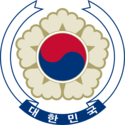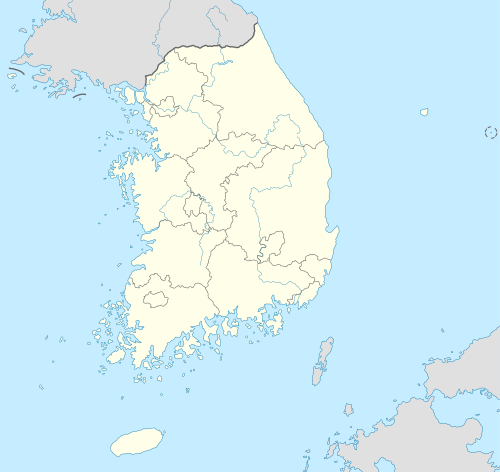التقسيمات الإدارية في كوريا الجنوبية
| التقسيمات الادارية لكوريا الجنوبية |
|---|
| مستوى المحافظات |
| محافظة (道 도 دو) |
| محافظة حكم ذاتي خاص (特別自治道 특별자치도 teukbyeoljachi-do) |
| مدينة خاصة (特別市 특별시 teukbyeol-si) |
| مدينة عمرانية (廣域市 광역시 gwangyeok-si) |
| المستوي البلدي |
| مدينة (市 시 سي) |
| مقاطعة (郡 군 گون) |
| منطقة (區 구 گو) |
| بلدة (邑 읍 إيوپ) |
| بلدية (面 면 ميون) |
| حي (洞 동 دونگ) |
| ري (里 리 ري) |
| كوريا الجنوبية |
 هذه المقالة هي جزء من سلسلة: |
|
|
| الحكومة |
|---|
|
السلطة التنفيذية |
|
المجلس الوطني |
| الانتخابات |
| موضوعات متعلقة |
|
إعادة توحيد كوريا |
|
دول أخرى • أطلس بوابة السياسة |
South Korea is made up of 22 first-tier administrative divisions: 6 metropolitan cities (gwangyeoksi 광역시/廣域市), 1 special city (teukbyeolsi 특별시/特別市), 1 special self-governing city (teukbyeol-jachisi 특별자치시/特別自治市), and 14 provinces (do 도/道), including three special self-governing provinces (teukbyeol jachido 특별자치도/特別自治道) and five claimed by the ROK government.[1][2] These are further subdivided into a variety of smaller entities, including cities (si 시/市), counties (gun 군/郡), districts (gu 구/區), towns (eup 읍/邑), townships (myeon 면/面), neighborhoods (dong 동/洞) and villages (ri 리/里).[3]
الحكم المحلي
تهجي الرومنة المعدلة الرسمية للكورية مُستخدَم
| المستوى | اسم المجموعة | النوع | هانگول | هانجا | RR روماجي | رقم (2014) |
|---|---|---|---|---|---|---|
| 1 | Upper-level local autonomy[4] 광역지방자치단체 廣域地方自治團體 |
Province | 도 | 道 | do | 12 |
| Special self-governing province | 특별자치도 | 特別自治道 | teukbyeol-jachido | 2 | ||
| Special city | 특별시 | 特別市 | teukbyeolsi | 1 | ||
| Special self-governing city | 특별자치시 | 特別自治市 | teukbyeol-jachisi | 1 | ||
| Metropolitan city | 광역시 | 廣域市 | gwangyeoksi | 6 | ||
| 2 | Lower-level local autonomy[4] 기초지방자치단체(Municipality) 基礎地方自治團體 |
City | 시 | 市 | si | 60 |
| City (specific) | 시 (특정시) | 市 (特定市) | si (teukjeongsi) | 15 | ||
| County | 군 | 郡 | gun | 82 | ||
| District (autonomous) | 구 (자치구) | 區 (自治區) | gu (jachigu) | 69 | ||
| 3 | N/A | City (administrative) | 시 (행정시) | 市 (行政市) | si (haengjeongsi) | 2 |
| District (non-autonomous) | 구 (일반구) | 區 (一般區) | gu (ilbangu) | 35 | ||
| 4 | N/A | Town | 읍 | 邑 | eup | 216 |
| Township | 면 | 面 | myeon | 1198 | ||
| Neighborhood (legal-status) | 동 (법정동) | 洞 (法定洞) | dong (beopjeongdong) | 2073 | ||
| Neighborhood (administrative) | 동 (행정동) | 洞 (行政洞) | dong (haengjeongdong) | |||
| 5 | N/A | Urban Village | 통 | 統 | tong | |
| Rural Village | 리 | 里 | ri | |||
| 6 | N/A | Hamlet | 반 | 班 | ban |
التقسيمات بمستوى إقليمي
The top tier of administrative divisions are the provincial-level divisions, of which there are several types: provinces (including special self-governing provinces), metropolitan cities, special cities, and special self-governing cities. The governors of the provincial-level divisions are elected every four years.[2]

| Code | Emblem | Name | Official English name[5] | هانگول | هانجا | التعداد إحصاء 2020 |
المساحة (كم²) |
الكثافة السكانية 2022 (per km2) |
|---|---|---|---|---|---|---|---|---|
| KR-11 | Seoul special city | Seoul | 서울특별시 | 서울特別市 | 9,586,195 | 605.20 | 15,578.16 | |
| KR-26 | Busan metropolitan city | Busan | 부산광역시 | 釜山廣域市 | 3,349,016 | 770.04 | 4,309.46 | |
| KR-27 | Daegu metropolitan city | Daegu | 대구광역시 | 大邱廣域市 | 2,410,700 | 883.49 | 2,675.25 | |
| KR-28 | Incheon metropolitan city | Incheon | 인천광역시 | 仁川廣域市 | 2,945,454 | 1,062.63 | 2,782.40 | |
| KR-29 | Gwangju metropolitan city | Gwangju | 광주광역시 | 光州廣域市 | 1,477,573 | 501.24 | 2,855.02 | |
| KR-30 | Daejeon metropolitan city | Daejeon | 대전광역시 | 大田廣域市 | 1,488,435 | 539.85 | 2,681.14 | |
| KR-31 | Ulsan metropolitan city | Ulsan | 울산광역시 | 蔚山廣域市 | 1,135,423 | 1,057.14 | 1,047.01 | |
| KR-50 | Sejong special self-governing city | Sejong Special Self-Governing City | 세종특별자치시 | 世宗特別自治市 | 346,275 | 465.23 | 824.93 | |
| KR-41 | Gyeonggi-do | Gyeonggi Province | 경기도 | 京畿道 | 13,511,676 | 10,184 | 1,336.10 | |
| KR-42 | Gangwon special self-governing province | Gangwon State | 강원특별지치도 | 江原特別自治道 | 1,521,763 | 16,875 | 91.06 | |
| KR-43 | Chungcheongbuk-do | North Chungcheong Province | 충청북도 | 忠淸北道 | 1,632,088 | 7,433 | 215.34 | |
| KR-44 | Chungcheongnam-do | South Chungcheong Province | 충청남도 | 忠淸南道 | 2,176,636 | 8,204 | 258.08 | |
| KR-45 | Jeonbuk special self-governing province | Jeonbuk State | 전북특별자치도 | 全北特別自治道 | 1,802,766 | 8,067 | 219.31 | |
| KR-46 | Jeollanam-do | South Jeolla Province | 전라남도 | 全羅南道 | 1,788,807 | 12,247 | 147.36 | |
| KR-47 | Gyeongsangbuk-do | North Gyeongsang Province | 경상북도 | 慶尙北道 | 2,644,757 | 19,030 | 136.64 | |
| KR-48 | Gyeongsangnam-do | South Gyeongsang Province | 경상남도 | 慶尙南道 | 3,333,056 | 10,533 | 311.26 | |
| KR-49 | Jeju special self-governing province | Jeju Special Self-Governing Province | 제주특별자치도 | 濟州特別自治道 | 670,858 | 1,849 | 366.74 |
التقسيمات بالمستوى البلدي
سي (مدينة)
A si (시; 市, pronounced [ɕi]) is one of the divisions of a province, along with gun. A city must have a neighborhood(dong) and can have towns(eup), townships(myeon) if the city is combined with urban and rural areas. Once a eup of a county (gun) attains a population of 50,000, the county can become a city. A city with a population of over 500,000 (such as Suwon, Cheongju, Cheonan and Jeonju) is considered as a specific city, which can set non-autonomous districts(gu). An administrative city does not have a city council and the mayor of the city is appointed by the provincial governor.
گون (ناحية)
A gun (군; 郡) is one of the divisions of a province (along with si), and of the metropolitan cities of Busan, Daegu, Incheon and Ulsan (along with gu). A gun has a population of less than 150,000 (more than that would make it a city or si), is less densely populated than a gu, and is more rural in character than either of the other 2 divisions. Gun are comparable to British non-metropolitan districts. Counties are divided into towns (eup) and townships (myeon). Specially, the size of a "gun" is less than a US "county".
Gu (district)
A gu (구; 區) is equivalent to district in the West. The metropolitan cities of Busan, Daegu, Incheon and Ulsan contain gun as well. Gu are similar to boroughs in some Western countries, and a gu office handles many of the functions that would be handled by the city in other jurisdictions. Gu are divided into neighborhoods (dong).
Submunicipal level divisions
Eup (town)
An eup (읍; 邑) is similar to the unit of town. Along with myeon, an eup is one of the divisions of a county (gun), and of some cities (si) with a population of less than 500,000. The main town or towns in a county—or the secondary town or towns within a city's territory—are designated as eup. Towns are subdivided into villages (ri). In order to form an eup, the minimum population required is 20,000.
Myeon (township)
A myeon (면; 面) is one of the divisions – along with eup – of a county (gun) and some cities (si) of fewer than 500,000 population. Myeons have smaller populations than eup and represent the rural areas of a county or city. Myeon are subdivided into villages (ri). The minimum population limit is 6,000.
دونگ (مجاورة)
A dong (동; 洞) is the primary division of districts (gu), and of those cities (si) which are not divided into districts. The dong is the smallest level of urban government to have its own office and staff. In some cases, a single legal dong is divided into several administrative dong. Administrative dong are usually distinguished from one another by number (as in the case of Myeongjang 1-dong and Myeongjang 2-dong). In such cases, each administrative dong has its own office and staff.
The primary division of a dong is the tong (통; 統), but divisions at this level and below are seldom used in daily life.[6] Some populous dong are subdivided into ga (가; 街), which are not a separate level of government, but only exist for use in addresses. Many major thoroughfares in Seoul, Suwon, and other cities are also subdivided into ga.[7]
ري (قرية)
A ri (리; 里) is the only division of towns (eup) and townships (myeon). The ri is the smallest level of rural government to contain any significant number of people.[8]
التاريخ
Although the details of local administration have changed over time, the basic outline of the current three-tiered system was implemented under the reign of Gojong in 1895. A similar system also remains in use في كوريا الشمالية.
انظر أيضاً
- التقسيمات الإدارية في كوريا الشمالية
- ISO 3166-2:KR, ISO codes for cities and provinces في كوريا الجنوبية
- قائمة المدن في كوريا الجنوبية
- List of South Korean regions by GDP
- Provinces of Korea
- Special cities of South Korea
المراجع
- ^ "Administrative division". South Korea Government. Archived from the original on June 1, 2008. Retrieved 30 April 2018.
- ^ أ ب "Local Governments". KOREA.net. Retrieved 30 April 2018.
- ^ Stevens, Andrew. "Seoul Mayor first among equals". City Mayors. Retrieved 30 April 2018.
- ^ أ ب "Local Governments". Korea.net. Retrieved 30 April 2018.
- ^ http://www.ngii.go.kr/en/download/Toponymic_Guidelines_ROK.pdf Archived 2017-03-12 at the Wayback Machine, p. 41.
- ^ 통 (in الكورية). Nate / Encyclopedia of Korean Culture. Archived from the original on 2013-04-11. Retrieved 2013-03-18.
- ^ "부산광역시 법정 동·리(洞·里) 현황 Busan city administrative units". Busan City. Archived from the original on 2012-05-18. Retrieved 2013-03-18.
- ^ 이 / 里 (in الكورية). Nate / Encyclopedia of Korean Culture. Archived from the original on 2013-04-11. Retrieved 2013-03-18.
وصلات خارجية
- "Local Government". KOCIS.
- "Seoul Mayor first among equals in South Korea local government". Citymajors.
- "South Korea Administrative Districts". CityPopulation.de.
- "ISO Subentity Codes for South Korea". GeoNames.
